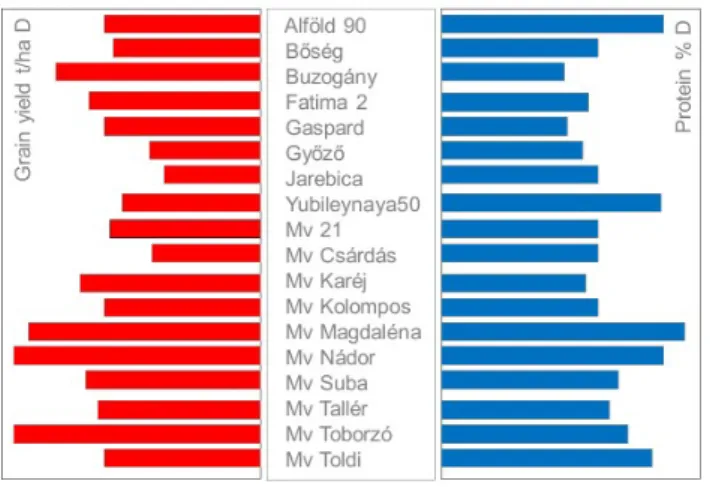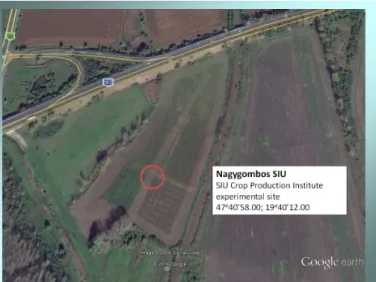Columella – Journal of Agricultural and Environmental Sciences Vol. 7. No. 1(2020)
Quality and quantity of winter wheat varieties in 22 years’ time range
Katalin M. KASSAI1– Ákos TARNAWA1– Ferenc H. NYÁRAI1– Zsolt SZENTPÉTERI1– Adnan ESER1– Hajnalka KATÓ1– Márton JOLÁNKAI1
1:Szent István University, Institute of Crop Production, Páter Károly u. 1., 2100 Gödöll˝o, Hungary, E-mail:
Jolankai.Marton@mkk.szie.hu
Abstract: The Nagygombos experiments of the Szent István University, Gödöll˝o, Hungary have always been a testing area for various agronomic technologies as well as a research site for evaluating the performance of crop varieties. The present paper is intended to give an overview of 18 winter wheatTriticum aestivumL.
varieties tested during the time range between 1996 and 2018. All of the varieties were studied under similar agronomic conditions, each of them for min 3 years in a series of a polyfactorial replicated field trial. The 120 kg/ha N plant nutrition applications of the respective crop years were processed in the evaluation. Amount of grain yield, protein %, wet gluten content and farinographic values of the varieties examined were compared.
The results obtained suggest, that most of the varieties had a rather high variation concerning yield figures, however protein and farinographic indicators proved to be more stable characteristics. Wet gluten content was influenced mainly by the crop year. The study may support a conclusion that certain varieties have shown a higher stability in technological quality manifestation regardless to the amount of their grain yield. Alföld 90, Yubileynaya 50, Mv Magdaléna and Mv Toldi varieties proved to be the best quality varieties in this research series.
Keywords: wheat, quality, quantity, long term trial
Received 08 November 2019, Revised 23 March 2020, Accepted 25 March 2020
Introduction
Environmental conditions are highly influ- ential regarding crop quality and quantity performance. Grain yield and yield qual- ity of winter wheat Triticum aestivum L. is highly influenced by the meteorological con- ditions of the given crop year, especially the amount and distribution of precipitation and the actual temperature (GRIMWADE ET AL 1996, GY ˝ORI 2008, PEPÓ 2010). Crop yield and grain quality can also be influ- enced by agronomic applications. Plant nu- trition in general and N topdressing in par- ticular should be considered as the most ef- fective treatments within the technologies of winter wheat production. The amount of ni- trogen and the timing and distribution of the application have an impact on wheat quality, especially on the protein production of the crop (GY ˝ORI 2006, PEPÓ 2010). Wheat va- rieties may have different responses to agro- ecological impacts (VIDA ET AL 1996;
MESTERHÁZY 2019). Varietal differences are to be evaluated in long term trials to re-
duce the impact of variable crop year effects (KISMÁNYOKY AND RAGASITS 2003).
Materials and Methods
A wide range of high milling and bak- ing quality winter wheat Triticum aestivum L. varieties were examined under identical agronomic conditions in a long term field trial. The small plot trials were run at the Nagygombos experimental field of the Szent István University, Crop Production Institute, Hungary. Soil type of the experimental field is chernozem (calciustoll). Annual precipi- tation of the experimental site belongs to the 550-600 mm belt of the Northern edges of the Hungarian Great Plain. Experiments were conducted in a split-plot design with four replications. The size of each plot was 10 m2. Plots were sown and harvested by plot machines (standard Wintersteiger ce- real specific experimental plot machinery se- ries). Various identical agronomic treatments were applied to plots. Plant nutrition applica-
Figure 1. Grain yield and protein content of wheat varieties Nagygombos, 1996-2018.
Figure 2. Wet gluten content and quality classes of wheat varieties Nagygombos, 1996-2018.
tions were done in single and combined treat- ments. N topdressing variants were applied by single and repeated topdressings repre- senting 6 levels: 0, 80, 80+40, 120, 120+40 and 160 kg/ha N in single and split appli- cations. All plots were sown with identical series of wheat varieties for studying their performance in relation with agronomic im-
rieties were studied under similar agronomic conditions, each of them for min 3 years in a series of a polyfactorial replicated field trial.
The 120 kg/ha N plant nutrition applications of the respective crop years were processed in the evaluation for both yield and qual- ity parameters. Wheat grain quality param- eters: protein and wet gluten contents were
Columella – Journal of Agricultural and Environmental Sciences Vol. 7. No. 1(2020)
laboratories according to Hungarian and EU standards (MSZ 1998; EK 2000, HORVÁTH 2014). During the examined period levels of fusarium head blight (Fusarium gramin- earum) infection were detected in the wheat trials.
Results
During the 22 years of the experimental se- ries many varieties had been studied in the trials (JOLÁNKAI ET AL 2018). In this pa- per only those are introduced which were tested for minimum 3 years at the Nagygom- bos site. Amount of grain yield, protein %, wet gluten content and farinographic values of the varieties examined were compared.
The results obtained suggest, that most of the varieties had a rather high variation concern- ing yield figures, however protein and farino- graphic indicators proved to be more stable characteristics. Wet gluten content was influ- enced mainly by the crop year.
Figure 1provides information on grain yield and protein content of the varieties. Bu- zogány, Mv Magdaléna, Mv Nádor, Mv To- borzó were the highest yielding varieties dur- ing the examined years. The study may sup- port a conclusion that certain varieties have shown a higher stability in quality manifes- tation regardless to the amount of their grain yield. Figure 2 presents information on the quality ranges of the varieties summarising the wet gluten content and the baking qual- ity groups. Alföld 90, Yubileynaya 50, Mv Magdaléna and Mv Toldi varieties proved to be the best quality varieties in this research series.
During the examined period fusarium head blight infection had been monitored in all
years. According to the data presented in Figure 3it can be stated, that except few ex- treme years the Nagygombos experimental site was not exposed to severe fusarium head blight infections. There were two peaks with high infection: 1997 to 1999 was a strong infection period followed by an almost 10 years’ free period of Fusarium sp. The next peak occurred in 2010. Both high infections were escorted by extreme weather conditions – like water flood during the pre harvest veg- etation period.
Discussion
According to the results obtained it should be emphasized that the quantity and quality pa- rameters of any crop varieties are to be exam- ined in polyfactorial long term trials that may provide the researcher identical conditions to exclude unfavourable factors and buffer the crop year effects.
The authors are sorry to inform the LOTEX participants that in 2018 year the Nagygom- bos experimental site of the SIU Crop Pro- duction Institute had to be terminated.Figure 4 attached presents a satellite photo of the experimental site from 2016. We do hope, that preserving the main blocks of the exper- imental design, once the trial can be restarted again.
Acknowledgements
The authors are indebted to all those, who supported the experimental work during the past periods – so the earlier OMFB, OTKA, NKFP, TEMPUS, COPERNICUS, VKSZ fundings as well as that of the present NVKP 16-1-2016-0016 project.
Figure 3. Occurence of fusarium head blight infection in wheat trials Nagygombos, 1996- 2018.
Figure 4. Satellite photo of the Experimental site of the SIU Crop Production Institute Nagy- gombos, 2016.
References
Grimwade, B., Tatham, A.S., Freedman, R.B., Shewry, P.R., Napier, J.A. (1996): Comparison of the expression patterns of wheat gluten proteins and proteins involved in the secretory pathway in
developing caryopses of wheat. Plant Molecular Biology. 30:1067–1073. https://doi.org/10.1007/BF00020817 Gy˝ori, Z. (2006): A trágyázás hatása az ˝oszi búza min˝oségére. Agrofórum. 17(9):14-16.
Columella – Journal of Agricultural and Environmental Sciences Vol. 7. No. 1(2020)
Jolánkai, M., Tarnawa, Á., Nyárai, H.F., Szentpétery, Z., Kassai, M.K. (2018): Agronomic ben- efits of long term trials. Columella Columella - Journal of Agricultural and Environmental Sciences.
5(1):27-30. https://doi.org/10.18380/SZIE.COLUM.2018.5.1.59
Kismányoky, T., Ragasits, I. (2003): Effects of organic and inorganic fertilization on wheat quality. Acta Agronomica Hungarica, 51(1):47-52. https://doi.org/10.1556/AAgr.51.2003.1.6
Mesterházy, Á. (2019): Kalászos fuzárium járvány, 2019. Helyzetkép és tennivalók. Hungarian Academy of Sciences, Section of Agricultural Sciences. Scientific lecture.
MSZ 6383:1998, 824/2000/EK Wheat quality standards.
Pepó, P. (2010): Adaptive capacity of wheat (Triticum aestivumL.) and maize (Zea maysL.) crop models to ecological conditions. Növénytermelés. 59. Suppl. 325-328.
Vida, Gy., Bed˝o, Z., Jolánkai, M. (1996): Agronómiai kezeléskombinációk ˝oszi búzafajták süt˝oipari min˝oségére gyakorolt hatásának elemzése f˝okomponens-analízissel. Növénytermelés. 45(6):453- 462.

